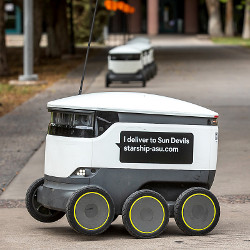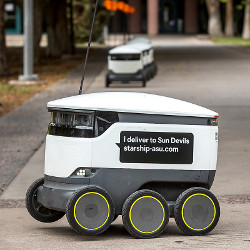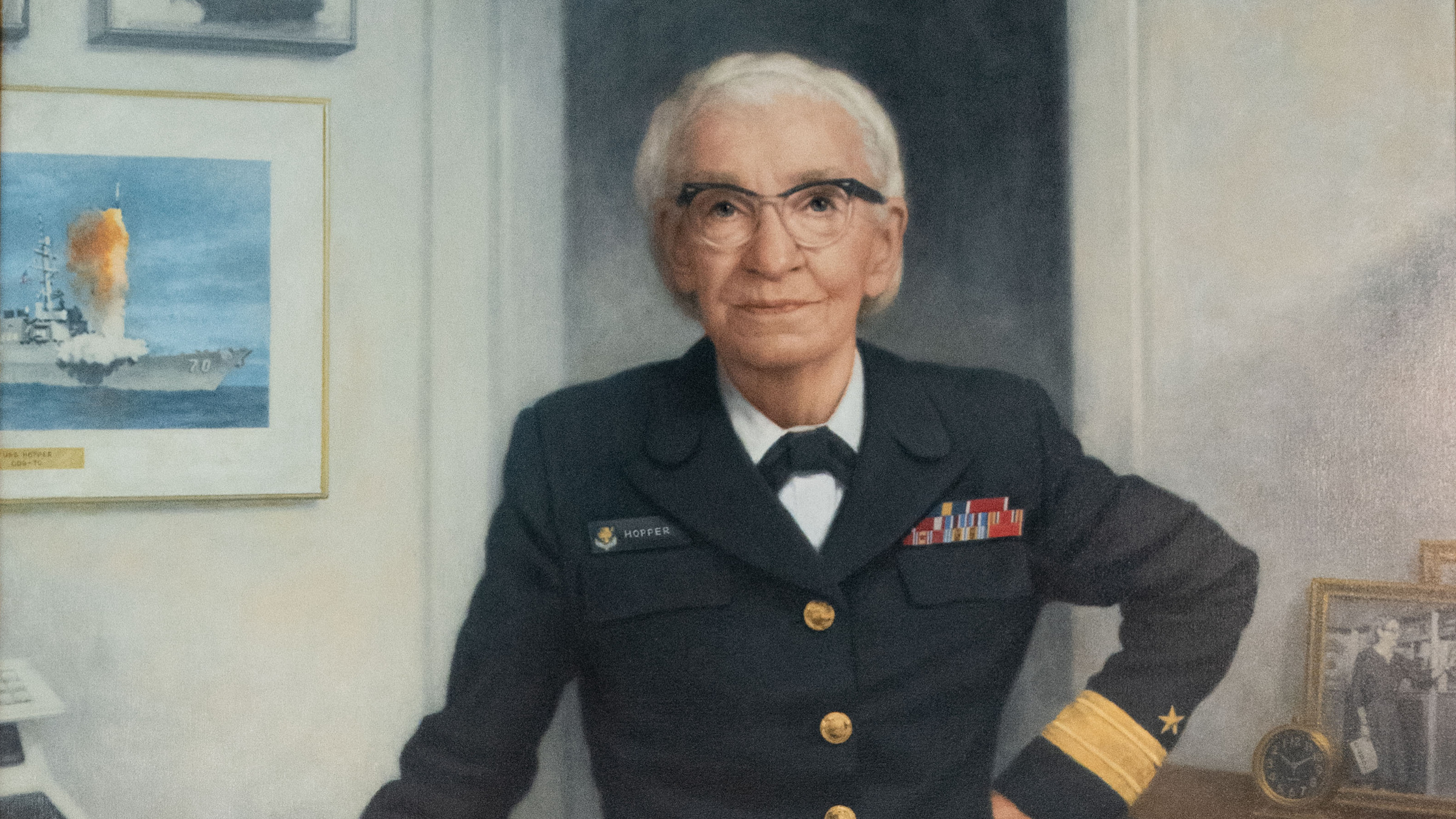
Today’s supply chains are labor-intensive and expensive to run. A number of autonomous systems that reduce the human factor are about to change all that.
What do the sidewalks around us, the airspace above us, interstate freeways, and deep ocean shipping lanes have in common? The answer is that they are all places where developers of autonomous technology are trying to revolutionize the economics of supply chains. The plan is to use robotic technology to deliver anything from packages to take-out food, groceries, or bulk freight in ways that can reduce the logistics industry’s dependence on that most expensive of supply chain costs: human labor. if the use of electric drivetrains can cut carbon emissions too, so much the better.
currently, van-based delivery over the last mile to homes may comprise as much as 40% of the overall transportation cost, even if a package delivered in Europe or the U.S., say, originated in Asia. This final stretch, also known as the “last mile,” has long been an early target for roboticists. A number of last-mile robots have moved from early trials into full-scale operations, as wheeled delivery robots now ply city sidewalks, delivering everything from groceries to pizzas; drones deliver food from the clubhouse to golfers on the green, and medical delivery drone services launched before and during the COVID-19 pandemic ferry drugs, tissue samples, coronavirus tests, and medical supplies to end users.
On the roads, makers of emerging breeds of driverless trucks are preparing to begin tests of autonomous, long-haul semi-tractor-trailers that they hope to run on high-volume freight routes between cities, shifting goods from city depot to city depot. At sea, the shipping industry—one of the world’s worst polluters as a result of its use of a filthy, sulphur-rich diesel called bunker fuel—is developing cleaner, electrically-driven, autonomous ships with artificial intelligence (AI) at the helm.
Ground Robots Hit the Last Mile
So just who is fielding, or trialing, these technologies? One well-known last-mile robot maker is an energetic startup called starship Technologies, based in San Francisco. Operating in the U.S., the U.K., Germany, Denmark, and Estonia, the company’s robots “are now doing thousands of commercial deliveries a day and millions of autonomous miles per year,” says Vice president Henry Harris-Burland.
Starship’s machines are lithium battery-powered, white plastic robots that travel at 5mph (8kph) on six stubby wheels. peppered with cameras, radars, and ultrasound sensors for collision avoidance, they use GPS, computer vision, and proprietary 2.5-cm-resolution maps to navigate. They use AI to continually improve their guidance system as they travel—by retraining a neural network when, for instance, an unmapped obstacle is regularly met on a route. “Our goal has always been to achieve 99% autonomy, and our hardware and software allow us to travel safely autonomously,” Harris-Burland says. The goal is not for 100% autonomy, he explained, because a remote human operator can assume radio (4G/5G) control if a robot gets stuck.
The COVID-19 pandemic has made contactless robotic delivery a more sought-after service. “It proved to be one of the most reliable ways to protect vulnerable populations and enable social distancing,” Harris-Burland says. In Milton Keynes, U.K., which has boulevards broad enough for many robots and pedestrians to share, Starship robot numbers tripled during 2020, with 100 droids now plying the streets—the largest robot delivery fleet anywhere in the world, the firm says.
Starship, however, is far from alone in this space. Lux Research, a market analyst in Boston, MA, says other key last-mile robotics players to watch are FedEx, Amazon, and Kiwi campus in the U.S., plus Zhen Robotics in China. Japanese technology heavyweight Panasonic has just joined the fray, too.
Lux advises industry watchers to be on the lookout for interesting robot combinations: ground robots could be disgorged from driverless vans, or perhaps carry their own parcel delivery drones.
Drones: In a Holding Pattern
Delivery drones are not ready for prime-time everywhere just yet. While they have long been put forward as ideal last-mile platforms, the practice of drone delivery to homes has yet to match the promise, at least outside early deployments in Asia. Instead of bringing packages to homes in regions like the U.S. and Europe, drones have instead been used for a handful of limited applications such as medical delivery applications.
In February, for example, Britain’s National Health Service pressed a 40-mile-range drone into service to ferry personal protective equipment (PPE), COVID-19 testing kits, tissue samples, and drugs between medical facilities in the remote Scottish islands. In May 2020, United Parcel Service (UPS) began a drone-based service delivering medical prescriptions to Florida retirement homes.
In Japan, the e-commerce/online retailing firm Rakuten Inc. has launched drone-based delivery services for food, while in China, online retailers Alibaba and JD.com are now doing likewise. In Europe and the U.S., would-be drone delivery players like Amazon are finding the regulatory environment is tougher—with a thicket of safety, reliability, privacy, insurance, and security issues to negotiate before they can launch their long-promised services.
Among those regulatory issues are the need to safely navigate the built environment in three dimensions, avoiding the likes of people, birds, vehicles, buildings, power lines, street lamps, and trees, as well as coping with adverse weather. Then there’s the thorny question of redundancy: how does an aerial drone with a failed battery, motor, or rotor recover, rather than crashing on a crowded street?
On top of all that, industry observers are getting nervous about the privacy implications of having a flying machine brimming with cameras hovering slowly into someone’s yard, as the potential for privacy breaches is profound. As a result, engineers at the Indian Institute of Science in Bangalore, for instance, are working on ways to ensure delivery drones can have privacy safeguards baked into their control software, but it is an open source work-in-progress project that is nowhere near ready for deployment.
“A number of regulatory issues must be addressed before drone delivery services are cost-effective at scale,” says David Kovar, CEO of Unmanned Robotics Systems Analysis (URSA Inc), a risk management firm in Manchester, NH. “Countries with more authoritarian governments are often able to drive through this process fairly quickly, but the U.S. is held back by a very slow bureaucratic process that is deeply focused on minimizing risk to manned aviation. It is very difficult to speed the process along, and we lack the data to truly understand the potential, and actual, risks.”
Until regulators stop butting heads, drone delivery rollout likely will continue to lag well behind ground robots in the autonomous delivery stakes.
Jonathan Rupprecht, an attorney in Palm Beach County, FL, specializing in drone litigation, says changing a single aspect of drone regulation tends to have a domino effect on others. “One modification causes all sorts of consequences in another area of the law, or in the cost of drone operations. When you try and scale this out to multiple operational environments that have unique ground- and air-risk profiles, it causes problems somewhere else.”
So the likes of the U.S. Federal Communications Commission, the Department of Transportation, and the Federal Aviation Administration end up at loggerheads. Until regulators stop butting heads, drone delivery rollout will likely continue to lag well behind ground robots in the autonomous delivery stakes. One market analyst, Urban Mobility Labs of Los Angeles, is predicting drone delivery services will not kick off proper in the U.S. until 2023.
Driverless Trucks: Station to Station
UPS’s drone delivery service for prescriptions is just one of the giant freight shipping firm’s autonomous delivery projects. UPS is also involved in another, more-ambitious plan: autonomous city-to-city driverless freight trucking, care of a partnership with self-driving truck systems specialist TuSimple in San Diego, CA, and its partner, truck maker Navistar of Lisle, IL.
Unlike other firms planning driverless trucks, like Tesla and Google-owned Waymo, TuSimple is not embedded in self-driving car heritage. Instead, TuSimple’s aim is to develop autonomous technology that is entirely customized for the unique environment in which trucks operate, rather than shoehorning robotic technology from driverless cars into trucks.
Unlike self-driving cars, which have a LiDAR and radar range of about 200 meters (more than 650 feet), TuSimple says a wider, longer, articulated 40-ton driverless semi-truck needs to look much further ahead when traveling at highway speeds. That is why it has engineered a system in which an array of high-definition cameras give its software knowledge of what’s happening on the road up to a full kilometer (more than a half-mile) ahead, which, it estimates, is twice as far as a human truck driver can anticipate upcoming road activity.
One upshot of this extreme-look-ahead technology is that the trucks need to brake far less often, saving fuel. In trials TuSimple’s 40-truck fleet is running in New Mexico, Arizona, and Texas—with safety drivers who can step in if needed—the company has found, in research verified by the University of California, San Diego, that the autonomous technology is burning up to 10% less fuel per trip than similar human-driven trucks.
Autonomous Ships: All At Sea
While Tu-Simple, UPS. and Navistar hope their fully autonomous trucks will be fit for unrestricted driverless operation by 2024, one firm is already set to out-innovate them and take away a chunk of their market: Kongsberg Maritime of Norway, which is in the vanguard of industry moves to make cargo ships, tankers, and ferries operate more autonomously, with much lower crew numbers than today.
At issue, says An-Magritt Tinlund Ryste, product director for next-generation shipping at Kongsberg Maritime, is that logistics firms are being pressed to improve their carbon footprints. Also, if the beginning and end of a truck’s journey is near the ocean, why not avoid trucks altogether and use an environmentally friendly, electrically driven ship that also is equipped with autonomy to keep crew costs low, to ply the sea route?
To prove such technology, the firm is building an 80-meter-long largely autonomous container ship for Norwegian fertilizer maker Yara International. Called the Yara Birkeland, the vessel will service ports that usually require 40,000 truck trips every year. “It’s not completely unmanned yet; it’s designed for reduced crew. And our approach to how this is done has been agreed with by the Norwegian maritime authorities,” says Ryste.
What encouraged construction of the Yara Birkeland, says Ryste, is the increasing level of autonomy being requested by operators of ferries and freight barges, in terms of navigation and docking which, if a vessel’s captain agrees, can be switched to autonomous mode.
Kongsberg Maritime is far from alone in seeking greater autonomy on the high seas. In the spring of this year, IBM and Marine AI Ltd. of Plymouth, U.K., experimented with a transatlantic drone called the Mayflower Autonomous Ship (MAS) in a bid to create a generalizable AI for ship control. Aiming to mimic the journey of the original Mayflower from Plymouth, England, to what became the Plymouth colony in the New World of 1620, the navigational intelligence at the heart of MAS is called the AI Captain.
“The AI Captain uses a true hybrid AI system, making use of deep learning, prescriptive logic/inference rules, and also optimization/linear programming. And deep learning-based object detection, classification, and tracking is at the heart of the computer vision system used for confirming and identifying navigation hazards,” says Don Scott, Marine AI’s chief technology officer.
Are there emergent properties that no one could have predicted that could constitute a risk to vessel safety? “It’s conceivable that we may encounter a novel set of circumstances that is out of the comfort zone of what we have trained the AI Captain for in the simulator, such that it temporarily isn’t certain what to do next,” says Andy Stanford-Clark, chief technology officer of IBM UK & Ireland.
“In this case, the ‘backstop’ is to stop, wait, look around, and decide calmly what to do next. That’s one of the benefits of autonomy at sea: things tend to happen a lot slower.”
At its heart, says Scott, the rule the AI Captain harks back to in adversity mirrors those of all the autonomous robots, drones, trucks, and ships headed for the supply chain.
“The prime directive is: Don’t hit anything.”
Constant, S.
NHS launches UK’s first COVID test drone delivery service in Scotland, Skyports, Feb. 23, 2021 https://skyports.net/2021/02/nhs-launches-uks-first-covid-test-drone-delivery-service-in-scotland/
Edwards, D.
UPS to use drones to deliver medicines to retirement homes in Florida, Robotics & Automation News, May 26, 2020. https://roboticsandautomationnews.com/2020/05/26/ups-to-use-drones-to-deliver-medicines-to-retirement-homes-in-florida/32453/
Gan, M., Qian, Q., Li, D., Ai, Y., and Liu, X.
Capturing the swarm intelligence in truckers: A foundational analysis for future swarm robotics in road freight. Swarm and Evolutionary Computation, April 2021. https://doi.org/10.1016/j.swevo.2021.100845
Greengard, S.
When Drones Fly, Communications, November 2019, Vol. 62 no. 11 https://cacm.acm.org/magazines/2019/11/240357-when-drones-fly/fulltext
Kern, J., Robinson, C.
Automating the Last Mile – A Market Research Report, Lux Research, March 12, 2020, https://www.luxresearchinc.com/automating-the-last-mile-executive-summary
Marks, P.
Eyes On The Skies: Delivery Drone Privacy Issues Arise, Communications, Feb. 2, 2021. https://cacm.acm.org/news/250268-eyes-on-the-skies/fulltext
Rupprecht, J.
The Truth About Drone Delivery No One Is Talking About, Feb. 4, 2021 https://jrupprechtlaw.com/drone-delivery/
The Mayflower Autonomous Ship https://mas400.com/
The Autonomous Ship Project: Key Facts About Yara Birkeland https://www.kongsberg.com/maritime/support/themes/autonomous-ship-project-key-facts-about-yara-birkeland/





Join the Discussion (0)
Become a Member or Sign In to Post a Comment